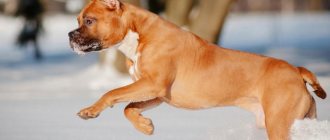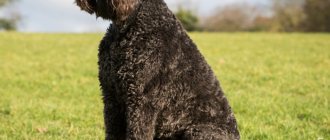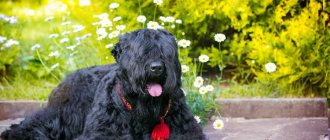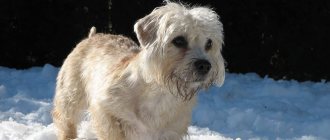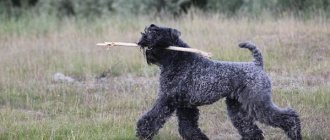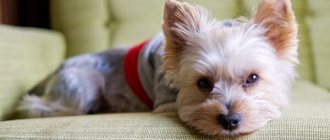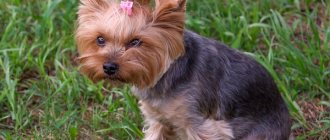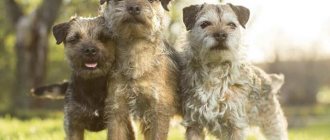Maintenance and care
This breed of dog can be safely kept both in a country house and in a city apartment.
If she lives in the city, she should have enough physical activity. In dangerous places (near highways), the Russell must be put on a leash, because, having obeyed the hunting instinct, he may not obey the owner’s orders. Jacks have three types of coat: hard, smooth and intermediate. The features of caring for it depend on this. As a rule, the dog is cleaned with a hard mitten, combed, and trimmed.
When a pet lives outside, shedding occurs twice a year. But a domestic dog will shed almost constantly. Visible white hair can be quite difficult to remove from furniture. Therefore, you will have to comb the dog. Moreover, do this carefully and regularly.
Wire-haired dogs should be trimmed: pluck out dead hair using a special knife. This procedure is quite delicate. An unprepared owner may accidentally damage the animal's skin, so it is recommended to entrust the work to a professional groomer.
You can't bathe him often. Its fur repels dirt and this natural lubricant should not be washed off. After walking in contaminated areas, simply wipe the paws and areas of contamination with special cleaning wipes or a damp towel.
Girls need to be bathed after the end of their heat. Show dogs are also bathed before each show.
Rules for communication between a child and a Jack Russell Terrier
A dog is not a toy!
She is a living being who, like a person, can experience pain. You cannot roughly or suddenly grab an animal, pull its tail, ears, etc. You need to be especially careful with a puppy.
Punishing a dog is prohibited
Only an adult does this, and only as a last resort. You can get your Jack Russell to follow commands with a stern and firm voice, but you don’t need to shout at him.
The dog is not always in the mood
Despite his playful nature, occasionally the Jack Russell will not want to play and this is normal. There is no need to force him - the breed does not tolerate this. When the dog begins to growl and bare his teeth, you should move away immediately.
The dog may unintentionally bite or scratch
Sometimes this happens during the game too. The child should not be scared. If a temperamental Jack Russell gets too excited, you need to stop playing, calm down and stop looking at the animal.
It is forbidden to feed the dog food from the table
She should be taught to eat from her own bowl and only food specifically intended for her. Otherwise, the Jack Russell may develop digestive problems.
You can only have close contact with your dog.
Any other unfamiliar dog, even the same Jack Russell, cannot be petted without the owner’s permission.
Due to its playful nature and amazing, overflowing energy, the Jack Russell is a breed that will give a lot of positive emotions to both children and adults. But in order for both you and your pet to feel comfortable living with each other, teach your child the correct attitude towards an animal from the very beginning. And then such a dog can become not only a wonderful playmate for the child, but also a devoted friend who will always be ready to protect him.
Jack Russell Terrier and Jack Parson Terrier: differences and characteristics
The study and individualization of this breed continues to this day. Characteristic features will help you learn to distinguish between both dog breeds. Main features:
- Limb length. Having examined the profile of the dogs, it is clear that Jack Parsons have much longer, slimmer and more elongated paws. Russells have shorter limbs and clearly defined knees. The size of the limbs affects the speed of movement, so parsons are considered much faster.
- There is a noticeable difference in price. The cost of a Jack Russell puppy is significantly higher. This is explained by the wide popularity of the decorative and show breed.
- Parsons are more common in Europe. Jack Russells are more common in Australia. This is where the bulk of the nurseries are located. To get a dog of the required breed, you need to contact only official representatives or professional breeders.
- Before buying a puppy, it is advisable to familiarize yourself with the dog’s pedigree and the achievements of the parents.
Note! In pet stores, on the market and from ordinary dog breeders, the chances of purchasing a purebred Jack are zero.
Parson Russell Terrier price
A few years ago, even the highest-quality Parson was cheaper than its Australian cousin the Jack Russell, but today prices for both breeds are about the same. In particular, Parson Russell Terrier puppies from parents with exhibition and working diplomas are sold for 30,000 - 40,000 rubles. Offspring from less famous ancestors, but with a full package of documents and vaccinations, will cost 20,000 - 25,000 rubles. Sometimes you can buy an average pet for 15,000 rubles, but in this case there is a high probability of getting a puppy with hereditary pathologies. Most breeders who sell Parson Russell Terriers at prices below the market average do not spend money on expensive veterinary examinations.
How to train to a diaper (toilet)
From the first days, you need to teach him to do his business using a special diaper or newspaper. To do this, at first you need to place a diaper or newspaper near the place allocated for the puppy. If the puppy made a puddle in another place, then blot them so that his smell remains and put this wet newspaper or diaper on the place you have chosen for the puppy's toilet. Closely monitor your puppy's behavior after he wakes up and after eating. Usually, before doing its business, the puppy looks for a place, spins around, and fusses. Without scaring the puppy, pick him up and place him on a diaper or newspaper, preventing him from running away from it. When the puppy manages, be sure to praise him. After some time, the puppy will get used to peeing on a diaper or newspaper. Gradually move the newspaper or diaper further from the puppy's place to a place convenient for you.
At what age can you walk a puppy?
You can go for a walk after vaccinations in 2-3 weeks. First, take the puppy out for 5 to 7 minutes, gradually increasing the walking time. It is advisable to walk on a leash!
How to properly wash a puppy?
You can wash the puppy for the first time only after vaccination in 2 weeks (if there is such a need). Wash the dog with herbal baby shampoo or shampoo designed specifically for puppies. Wash off the foam very carefully in the shower. Wipe dry with a towel, then dry the wool under a warm stream of air (hairdryer), then wrap it in a towel for 30 minutes until completely dry. When washing, insert cotton swabs coated with cream or Vaseline into your ears to prevent water from getting into your ears.
How to clean your Jack Russell puppy's ears?
Clean your ears once a week (the pinna and shallowly in the ear canal, 0.5 cm deep). Moisten cotton wool with special products (for cleaning dogs’ ears, alternating the composition: against ticks and otitis media). Brush until the cotton wool is clean. At the end of the procedure, you need to wipe your ear with a dry swab.
Best Large Dog Breeds with Photos and Names
Grooming
Brush the coat 2-3 times a week. From a young age it is necessary to learn to comb your hair and perform all procedures on the table, because... in the future, during grooming and at shows, the dog should be able to stand calmly on it.
How to trim claws?
The claws of a puppy and an adult dog are trimmed as they grow using nail scissors or a special tool - a nail clipper. In the summer, as a rule, the claws wear down well on hard ground and asphalt, but in the winter they can grow strongly and break. Overgrown claws interfere with the dog’s movement, break off, change the gait, paw placement, and posture.
When does a Jack Russell Terrier's teeth change?
Permanent teeth (replaced after 7 months) should be brushed once a week with a special toothpaste for dogs or a piece of sour apple, and if they are missing, with odorless tooth powder or crushed chalk, avoiding the formation of yellow plaque or tartar. Second method – It is recommended to give a bone with cartilage once or twice a week.
Getting ready for the exhibition
Already a small puppy must be prepared for exhibitions. Stand it up regularly. In the ring, the dog should walk slightly ahead of the owner, stand calmly in an exterior stance, allow itself to be measured and show its teeth. All this should be taught to the puppy in advance.
Walk
It is recommended to take the puppy outside after all vaccinations and pest control have been completed. The time of the first walks should be 10-15 minutes, then it gradually increases to at least 2 hours a day. In winter weather, to avoid hypothermia, you should get warm clothes for your dog. In hot weather, it is better to walk your pet in a shaded area.
It is advisable to find a fenced area to let your dog off the leash. He needs to be given time to hunt small animals. The Jack Russell loves to sniff around and dig holes in the hope of getting to his “prey.”
Important! Regular street walks have a positive effect on the overall health of your four-legged friend, so you need to go outside every day, regardless of weather conditions
Terriers need long and frequent walks with active games.
The Jack Russell is an active breed and is suitable for people with the same active lifestyle. The owner will never get bored with such a cheerful pet
It is important for owners to satisfy their pet’s needs for movement and timely care. Regular hygiene procedures and a balanced diet contribute to the dog’s healthy development and attractive appearance.
Education and training
Paradoxically, the little Parson Russell Terrier is prone to dominance, so it is important not to miss and stop the moment when the dog senses the “big boss” in himself. To do this, after the puppy moves to a new apartment, you will have to clearly outline the boundaries of what is permitted. In particular, no matter how affectionate and funny the Parson Russell may be, he has no right to occupy your bed - the dog has its own place in the house, and it should only sleep there. Begging and sudden attacks must be stopped immediately, because this is nothing more than a cunning test of the authority and compliance of the owner.
Never put your pet in the front seat of a car, thereby making the animal equal to you. The breed loves to travel, but even more loves to “steer”, both with a vehicle and a person. During walks, the Parson Russell Terrier will also have to instill the rules of etiquette. Of course, it won’t be possible to wean a dog from ruining flower beds and hunting moles, but it’s definitely worth prohibiting barking at large aggressive dogs and picking on them if your pet’s life is valuable.
Teams will have to tinker with training Parson Russells, so if training is difficult, you can cut yourself and your pet a little slack and stick to the simplified UGS course. This amount of knowledge is enough to safely take your dog out onto noisy city streets. By the way, even a Parson Russell Terrier pretending to be a universal good boy is strictly contraindicated to let off a leash in open spaces. Otherwise, you will be looking for a four-legged traveler for a very long time.
Is it worth buying a dog for home?
Before purchasing a Jack Russell Terrier, carefully read the breed description.
These are ideal companions for children over 10 years old, athletes, and active people. But this option is not suitable for lazy people, busy at work, weak-willed individuals, or simply the elderly. This division occurs due to the strengths and weaknesses of this breed.
Pros of the breed
The immediate benefits include:
- Cheerful disposition. These are very cheerful dogs, they are often used for the rehabilitation of military personnel after injuries, people suffering from psychological illnesses and deep depression, since positive energy literally splashes out of these kids in all directions.
- Fast learner. With the right approach, the dog absorbs new skills and commands very quickly, and therefore often shows excellent results at shows.
- High intellectual abilities. Today, Jack Russells are widely used in customs and police work, since these dogs do not just follow a scent or look for a scent - they are able to make thoughtful decisions, cut corners to reduce distance, etc.
- Still an ideal breed for hunting small game, the Jack Russell is also an excellent athlete. Thanks to its physical abilities and activity, such a dog can be exposed to long periods of stress, from which it enjoys.
- In life, as in “The Mask,” this dog adores its owner, is sensitive to changes in mood and loves to please him.
- The terrier is also a good watchdog. There are cases when these dogs bravely attacked opponents that were superior in size and number, and their loud barking is an excellent deterrent for burglars.
- Jack Russells are low maintenance.
Did you know? Among the Jack Russell Terriers there is an artist named Tillamook Cheddar from the USA, who has already had several exhibitions in Belgium, the Netherlands and at home, and some of his works have been bought for $2000.
Despite such an extensive list of advantages, there are still some pitfalls in the characteristics of this breed.
Disadvantages of owning a Jack Russell Terrier
Paradoxically, the shortcomings of these dogs come from their strengths:
High activity. Many future owners have no idea how much Jack Russells love movement. Doesn't like loneliness. Having locked the Jack Russell in the apartment and gone to work, the owner risks seeing ruins upon his return. The animal begins to get bored, and its poor health results in sabotage. If you can’t take your dog with you, you need to at least turn on the radio. Heavy shedding, the fur from which is clearly visible on dark furniture and carpets. Stubbornness. If this dog doesn’t like something, it’s difficult to convince him otherwise
Therefore, it is important that its owner also has a strong character, otherwise the terrier will feel like a leader, and then there can be no question of any obedience. Cunning. Intelligent Jack Russells can be very cunning when it comes to finding treats or evading training.
Their owner must always remember this and not fall for tricks. Passion for digging. Terriers have a habit of digging that dates back to the days of fishing foxes out of holes. Therefore, if you take such a baby to the dacha, you may be left without a garden. Aggression and jealousy. Despite their small size, these terriers are big owners. They do not tolerate competition in their territory, even from their own kind, they are not good friends with other animals and can start doing tricks if they see that their beloved owner is paying attention to someone else.
Important! An hour a day of lazy jogging on a leash will not be enough for them. Running through puddles, playing ball, chasing birds - all this should be in their life, otherwise the animal’s excess energy will eventually transform into bad habits: the dog will chew furniture, things, and may break or smash something.
The best Kennel Cavalier King Charles Spaniel in Moscow
Character of the Parson Russell Terrier
The Parson Russell Terrier is like a little hurricane in canine form. These funny, energetic rascals are so restless in their adventures that in order to avoid trouble, their impulses have to be carefully restrained. As an example: for a Parson Russell, it is a sacred thing to bark at any dog, even the most formidable one, not to mention cats, which must be immediately caught up and brought to a state of shock.
In the family, the pet behaves friendly and emotionally, trying to participate in all the endeavors of the household. But it’s better not to get a Parson Russell for introverts - spotted Energizers won’t sit in a corner for hours waiting for the owner’s call. In extreme cases, they will begin to bark resentfully and boringly in an attempt to attract attention, or they will come up with more sophisticated entertainment, as a result of which the owner will have to think about renovating the apartment and buying new furniture.
Due to their playful and extremely curious nature, Parson Russell Terriers easily join children's groups. By the way, it is children who become ideal companions for a dog that does not work according to the beast - where else can an overstayed animal let off steam, if not in endless hide-and-seek games! So if your young heirs have an idea of the rules for handling pets, from time to time the “burden” of walking and entertaining the dog can be shifted onto them.
The Parson Russell Terriers' passion for digging up soil has not escaped them, and nothing can be done about it. Moreover, sometimes representatives of the breed go to completely extreme actions. For example, the Internet is full of videos in which the main characters are Parson Russells digging up an imaginary treasure right in the center of a muddy puddle or dung heap. However, this behavior also has its advantages: the chances of becoming a YouTube star and collecting millions of views from these white-haired “archaeologists” are high, like no other breed.
Purpose of both breeds
Before buying a dog, you need to decide for what purpose the animal will be purchased.
The Jack Parson Terrier is an animal with excellent hunting instincts. They are often purchased for guard purposes. Pets prove themselves to be good companions who never leave their owners’ side.
Most dog lovers don't see the difference.
Parson Terriers know how to listen to their owner and are easy to learn commands. Pets have a special structure of the body and limbs, which are designed for fast movement on any terrain.
The dog Trump became the first representative of the Russell Terrier breed
The Jack Russell Terrier has similar features, but differs in body structure. Due to the characteristics of the body, Russells are not as adapted to complex loads as Parsons.
Note! Jack Russells are cleaner. They are more relaxed about hygiene procedures and also like to wear clothes
Russells are often bred for home breeding. They are used as decorative breeds, which are ideal for keeping in an apartment.
History of the Parson Russell Terrier breed
The Parson Russell Terrier is one of the few breeds in whose pedigree there are no white spots, despite the fact that its roots go back to the 18th century. Moreover, history has preserved the name of the creator of the “Parsons,” who was the English pastor John Russell from Devon. In his youth, the monk loved hunting on horseback, so he set out to breed a dog that would accompany the rider on his trophy trips.
Russell chose terriers as the basic breeding material, which he initially tried to cross with other breeds. Soon the pastor got tired of messing around with puppies that showed no promise in terms of work, and he began breeding all varieties of terriers in a row. The breeder-enthusiast did not focus on the exterior of his own pets, preferring to pay attention to the hunting inclinations of the litters, so the first “Parsons” could not boast of an expressive and uniform appearance.
Until about the middle of the 20th century, the Parson Russells remained in the shadow of their more successful relatives in the group. Dogs were bred and hunted with, but they were in no hurry to standardize them. It is unknown how long this neglect on the part of cynological associations would have continued if World War II had not broken out in Europe, during which Reverend Russell’s dogs began to be exported to the USA and countries of the Eurasian continent, which made them more popular.
However, the military actions had little effect on the formalities associated with entering the breed into the stud books, so for more than forty years the dogs did not have their own standard. The first step towards registering Parson Russell Terriers was taken by the English Kennel Club, which in 1990 developed a temporary appearance standard for the pastor’s charges. However, the official recognition of the FCI for the breed came only in 2001.
Breeders' recommendations
For people interested in purchasing a Jack Russell with show prospects, breeders recommend purchasing a dog only in a kennel or through a club, but not on the market or through an advertisement.
They advise choosing a medium-sized puppy from the litter, not too large, but not the smallest, as he is more likely to grow into a standard-sized dog.
It is desirable that the baby with exhibition prospects has a bright, beautiful color, and that the colored markings on the head and face are located symmetrically.
A small show-class Jack Russell should look moderately well-fed and proportionally built. He has a flat back, rather short strong legs and a not too long tail.
Breeders recommend that future owners take a responsible approach to choosing a Jack Russell and not rush into purchasing a pet.
They believe that it is better to go for a high-quality puppy with show prospects to another city or even another country than to buy a mediocre dog that is of no interest either as a show dog or as a breeding dog.
How to choose a puppy
- Before going to the nursery, decide which line you need. Show dogs must be purchased from a breeder who travels with his own breeders to exhibitions, and working puppies must be purchased from breeders who train and take their charges out hunting.
- Newborn Parson Russell Terriers are very similar to Jack Russells, therefore, in order to avoid being deceived by an unreliable seller, it is better to wait until the animal is 8-9 months old.
- When choosing a Parson as a pet, pay attention to its behavior. Overly assertive and eager to grab a stranger by the pants, puppies are good for hunting, but not for living in the same apartment with small children.
- The dominant coat color of the Parson Russell Terrier is white (at least 70% of the body must be this tone). If you are offered puppies that are too spotted, this is a breed.
- Pay attention to the puppy's movements. They must be linear and coherent. An unsteady gait, slight lameness, trembling and a shaking head are signs that the animal is unwell.
- Study the pedigrees of the parents of the Parson Russell Terrier you like and make sure that they are not littermates.
- Discuss the possibility and timing of returning the puppy to the breeder if something does not suit you. This gives you a chance to take your baby to the veterinarian for examination on your own to check his health and identify genetic diseases.
How to maintain and care
In everyday life, the Jack Terrier is extremely unpretentious and docile. But we should not forget that when kept in an apartment, he needs physical activity, an influx of fresh impressions, so you need to take him for a long time and partly for a walk. The Russell's coat is quite short, and it is enough to brush it weekly, and after running through the slush, the terrier needs to be washed so that dirt and microorganisms do not harm him. But do not overdo it: frequent water procedures can harm the Russell’s skin: dry it out, initiate the appearance of dandruff, cause hypothermia if the not-dry terrier suddenly finds itself in the cold.
You should also regularly pay attention to the dog’s ears to see if water has gotten into them, clean the ear canals with cotton swabs with a drop of hydrogen peroxide or a special hygienic composition from the pet store. Long and fairly quick exercise (a walk in the fresh air) is a terrier’s need.
Without them, he will feel sad, his discipline and health will weaken. In order for your pet dog to get his daily walking quota, you need to walk him at least 2 times every day for a fairly long time. Play with him, let him run through the wasteland, chase sparrows - these activities make the dog happy and lively
Long and fairly quick exercise (a walk in the fresh air) is a terrier’s need. Without them, he will feel sad, his discipline and health will weaken. In order for your pet dog to get his daily walking quota, you need to walk him at least 2 times every day for a fairly long time. Play with him, let him run through the wasteland, chase sparrows - these activities make the dog happy and lively.
Description and features
The Russell Terrier breed is not suitable for classic work activities. The breeders did not endow her with a natural hatred of suspicious strangers and a high level of observation. But, its representatives can be extremely useful in everyday life, as guards against harmful rodents.
The small size of such a dog allows it to crawl into a gorge, hole or hole in order to catch a self-confident and nimble animal that annoys people with its presence. Her hunting abilities are excellent. The animal rapidly chases its prey, overcoming all obstacles with lightning speed, and when it catches up with it, it will not spare it.
It is worth noting that it is useless to train him to catch large animals, because due to his natural miniature size, this dog will not be able to cause damage to a deer, wolf or other massive animal. However, the French skillfully trained him to hunt a forest wild boar.
In some provinces of France, such a dog still performs a rather unusual service. For example, in Champagne it is used as a hunting hound that tracks prey along a bloody trail. But in Ireland they rarely go into the forest with her to catch animals. There the dog is used to hunt game birds, mainly wild ducks.
The representative of the breed is one of the best rat catchers. It is also advisable to train it on squirrels, muskrats, badgers, rabbits and hares. And some Parson Russell Terriers even manage to catch a fox.
Farmers are happy to keep such representatives of the animal world, but not for exploitation, like shepherds. Such pets protect their barns and warehouses from voracious mice and rats. The interesting thing is that they can do this “work” together with a cat.
But the ability to run fast, an excellent sense of smell and excellent abilities as a hunter are not all the advantages that a dog has. For many people, she is an excellent companion, a loyal comrade and a reliable friend. It’s a pleasure to spend time with her, because she always feels the mood of her owner, and also knows how to adapt to him.
According to the popular version, this breed was selected by an English priest, Reverend John Russell, who always really liked burrow hunting. However, he was unable to find the right dog for such a task.
That is why the monk decided to create it himself. dog Parson Russell Terrier was born .
Diseases
The Russell Terrier is characterized by ailments of hereditary origin. But in case of early detection and timely therapeutic measures, the family pet is able to live a long and happy life, delivering positive emotions to all of you for a decade and a half.
Typical Russell diseases are:
- Eye diseases: cataracts and lens displacement.
- Musculoskeletal ailments: patella displacement, hip dysplasia, Perthes disease.
- It is not so rare that the white color of the Russell is combined with a congenital inability to hear sounds.
In addition, the Russell's instinctive functions can lead to health problems. He constantly pursues small animals, as well as skunks (in North America). The secretion of these animals, released as a protective measure, is biochemically active, and it is capable of initiating toxic shock syndrome in animals.
Health and disease of Parson Russell Terriers
“Parsons” and “Jacks” have a common set of diseases, and quite serious ones at that. For example, representatives of both breeds suffer from hereditary joint dysplasia, so when buying a puppy from a kennel, ask the seller whether its producers have been examined for this disease. In addition to dysplasia, Parson Russell Terriers are susceptible to various types of arthritis and Perthes disease, and this, at a minimum, means the animal loses hunting qualifications, and at a maximum, complete disability.
Congenital deafness is another scourge of the Parson Russell family, and, oddly enough, the coat color is to blame for this: according to statistics, the majority of deaf puppies have white “fur coats.” At an early age, it is extremely difficult to notice deafness in terriers, since the breed has a phenomenal sense of smell and hearing defects do not prevent it from being well oriented in space. For this reason, it is better to entrust the matter to a veterinarian, who will conduct tests to identify deafness and make the right verdict.
The Parsons' visual organs need close attention. A pathology such as “collie eye” can cause cataracts and then complete blindness in the dog. This disease has no cure, and the only thing that can be done in such cases is to examine the puppy who has not had time to grow up and stop the development of the disease, partially preserving vision. Parson Russell Terriers are familiar with allergies and even diabetes, which obliges owners to be extremely careful when preparing a natural menu for their pet.
Breed characteristics, behavioral characteristics
This breed is characterized by its small stature, which allows the animals to easily crawl into holes and move nimbly through them. Russell walks with a springy, relaxed gait, his strong paws provide him with high speed and running time in pursuit of game. Its strong jaws and strong fangs provide a reliable grip on prey, both underground, on land and on water. As mentioned above, this breed is characterized by a light or white color with dark or brown spots.
If you decide to get your own pet Russell Terrier, you will most likely find a cheerful, loyal and friendly companion. He will be happy when all your household members get together. Four-legged friends love to take walks with you for company and willingly play outdoor games with their owner. They are characterized by extraordinary activity and liveliness of nature.
Let's name a few more characteristic character traits:
- Russell is cheerful, friendly to his owners, and willingly plays with them. And he does not lose these qualities until old age. Like other small breeds (dachshund, beagle and others), with proper care, the Russell can live up to 15 years, but even in his “retirement” years he will not stop entertaining household members with his gaiety.
- This breed is brave and can behave independently, which sometimes causes difficulties in training.
- The Jack Terrier is friendly towards children and is not aggressive towards strangers - but only if it is raised properly.
- A powerful hunting instinct forces him to rush at cats and other small animals, including those he saw on the street. All these creatures are just likely prey, and the dog is able to attack them to make them prey.
- The breed is characterized by curiosity, and the boring and monotonous life of Russells is depressing. They need a rotation of vivid impressions to satisfy their interest in the world around them.
- They are distinguished by endurance and restlessness. Therefore, it is better to get a Russell not for those who prefer to lie down or live at the computer most of their free time. The best owner is a restless person or a family in which it is customary to constantly move, play, travel, and work in the fresh air. Terriers need exercise to stay healthy.
The best education and training of Tibetan Mastiff dogs
Hunting with a Parson Russell Terrier
Unlike their Jack Russell cousins, Parsons have not yet transformed into an exhibition and decorative breed, but all the prerequisites for this exist. For example, today few people go after a badger with a terrier, for fear of injuring the pet, although baiting on foxes still takes place. The breed has proven itself well in hunting wild boars - the miniature dimensions of Parson Russell Terriers are more than compensated by their viciousness towards the animal, which has long been considered an obligatory attribute in the character of a hunting dog.
It turns out that Parson Russells can work in dense bushes, as well as stand “on the feed” of downed animals and birds. And yet the real element of terriers is burrows. It is in them that animals feel especially at ease. So if you plan to go hunting for foxes and raccoons with your pet, take a baiting course in artificial burrows, which are equipped in many hunting clubs. Another advantage of the Parsons is mobility. Such small dogs are convenient to transport over long distances, and the animals themselves willingly travel in company with their owner.
In general, the Parson Russell Terrier does not need long-term training in hunting - the dog is capable of getting hold of small animals without prior baiting. You can verify this by talking with breed breeders. Almost each of them has a dozen stories about how the Parson Russell returned from a walk either with a garbage rat or with a mole dug out of a hole. So in most cases, the essence of training a four-legged hunter comes down to teaching discipline and working contact with the owner.
The right diet
Keeping jacks involves not only hygienic care, but also proper timely nutrition. A healthy diet is the key to strong bones, a strong immune system, energy and good mood.
You can feed Russells with ready-made dry food. It is convenient to store, transport, pour and easily measure the required amount. In addition, the granules contain the necessary complex of vitamins and minerals.
But low-quality dry food leads to gastrointestinal imbalance and serious health problems. Therefore, it is better to opt for super-premium products for small active breeds.
Natural nutrition should consist of raw (thawed or scalded) lean meat and complex carbohydrates. Chicken, turkey, beef, rabbit are suitable. By-products can be used. Not all Russell Terriers love fish, but you can pamper your Jack with seafood.
Allowed cereals:
- oatmeal;
- buckwheat;
- barley porridge.
Vegetables:
- carrot;
- zucchini;
- beet.
If Russell loves fermented milk products, then you can add kefir, cottage cheese, fermented baked milk, and sour cream to the diet.
One of the features of keeping Jack Russell puppies is feeding them 4–5 times a day. Up to 3 months, babies are fed 5-6 times, up to 5 months - 4 times, only by the age of one year are they transferred to two meals a day. The serving size is determined by the formula: 20 g of food per 1 kg of Russell Terrier weight.
Nutrition
For such an energetic and active dog as the Parson Russell Terrier, proper and balanced nutrition is simply necessary; this is the most important thing in all the care of this breed. Since these dogs are very active, they need the most correct balance of proteins, fats and carbohydrates.
About 40-50 percent of an animal’s diet needs meat, usually beef, turkey, rabbit, and less often horse meat. Fatty meat (pork and lamb) should be excluded from the Parson Russell Terrier's diet, since they need fat in minimal quantities.
Wirehaired Parson Russell Terrier
Once a week you can give white fish (be sure to make sure it is boneless) and one boiled chicken egg (you can give two or three quail eggs instead). It is recommended to include by-products such as liver, kidneys, and stomachs in your dog’s diet. To strengthen the bones, the dog is given cottage cheese, from which they also get a sufficient amount of fat.
In order for your dog to receive the necessary carbohydrates, buckwheat, oatmeal and rice should be included in its diet. Pearl barley is contraindicated; you can give semolina, but it will not be of much use, it does not contain the necessary nutrients. Among the vegetables, carrots, bell peppers, dill, pumpkin and zucchini are very useful.
What to feed a Jack Russell puppy (so it doesn't eat your cat :))
At first, it is necessary to follow the breeder's recommendations, i.e. continue to feed the way the puppy was accustomed to eat from the first weeks of life. It is most convenient to feed with dry high-quality food recommended by the club.
Feeding regimen and diet
Natural feeding. The diet of a puppy (and an adult dog) must contain animal products in certain proportions: 75% - products of animal origin, 25% - of plant origin.
A Jack Russell Terrier puppy needs to be taught to eat what he should get, not what he likes. Overfeeding not only leads to excessive obesity with the ensuing consequences, but also accelerates the growth rate of the puppy, which often causes problems associated with bone development. Avoid overeating to ensure your puppy's optimal growth rate. Feeding regimen. Quality, quantity and time are the main thing!!!.
How to feed a Jack Russell correctly?
During the first week, it is recommended to add HONEY to the water.
The dog should be fed from a stand, adjusting its height as it grows. Fresh (filtered or boiled) water in a special container should be placed in a certain place on the stand. If the dog does not immediately eat the food, it must be removed after 15-20 minutes.
Food should not be hot or cold. The optimal food temperature should be slightly above room temperature. Feed concentration may vary. An adult dog should be fed 20-30 minutes after a walk, or 2-3 hours before. Never force feed your dog! The consistency is thick sour cream.
The dog should not know the taste of smoked meats, sweets, fried, salty and fatty foods.
Don't raise your puppy to be a beggar, don't give him scraps from the table.
Dogs essentially have to regulate the amount of food they eat themselves. Therefore, the owner himself must regulate the amount of food depending on the age, season of the year, and the dog’s load. Food should be concentrated (nutritious), not bulky.
The cause of excess weight may be excessive feed consumption caused by loss of self-regulation, feeding high-calorie, fat-rich foods, or increasing the portion of feed. In dogs, excessive fat deposits or the other extreme, when the bones are covered with skin, are unacceptable. In a normally well-fed dog, when lightly pressing on the sides, the ribs should be palpable.
What to feed a puppy at 1.5 -4 months
Feeding 4 – 5 times a day. The puppy's rapid growth and feeding should be complete and high-calorie, containing vitamins. The puppy should receive boiled meat (chicken breasts or beef) with rice, vegetables and vegetable oil, eggs 2 - 3 times a week. From this age they begin to give boiled sea fish 2 times a week. Sour-milk products in small quantities, give vegetables and fruits daily. (Apples are healthy. Beets and carrots can be either boiled or grated raw. All vegetables and fruits are served with low-fat sour cream or vegetable oil.) From porridge - rice and buckwheat.
What to feed a puppy at 4-6 months.
Feeding 3-4 times a day. This period of life is still stressful. The puppy continues to grow, teeth change, the coat matures, this is one of the periods of puberty. The physiological and psychological stress on a puppy is enormous and you should be very attentive to your pet.
How to feed properly at 6-9 months.
Up to 9 months, try to feed 3 times a day. Nutrition during this period is not much different from the previous one. The puppy should still receive the same set of foods. By this period, the main growth of the puppy has been completed, the teeth have been replaced, however, the formation of the skeleton and muscles has not yet been completed and occurs precisely during this period of the animal’s development. High-quality meat in sufficient quantities will significantly contribute to this.
Breed standard
— The body build of this dog is sinewy, dry, the breed is a medium-sized dog. The height at the withers for males reaches 36 centimeters, for females - 33 centimeters. The error (more or less) is allowed only two centimeters.
— The skull is moderately wide, tapering towards the eyes, the nose is black (other shades of the nose are not allowed). The jaws are muscular and strong, the bite is scissor-shaped, correct, the upper teeth of the animal should fit tightly to the lower ones, as well as the lips.
— The ears are compact, in the shape of the letter “V”; according to the standard, the edge of the ear should reach the corner of the eye, and the fold line cannot exceed the top line of the skull. The ears hang forward, are located close to the head, and their stance is completely inappropriate.
— The eyes are deep-set, dark in color, almond-shaped incision.
— The neck is very muscular, widening towards the shoulders.
— The croup is straight, the chest is moderate, the ribs are not too compressed, the loin is slightly convex, everything looks harmonious and balanced.
- Feet: Compact, muscular, pads straight and firm, with straight elbows, turning in or out is not allowed. The shoulder blades are inclined, extended back.
— The average weight fluctuates around 8 kilograms, but rarely exceeds 10.
— The gait is light, free, not stiff and very well coordinated. All movements are straight.
— The coat is hard, the hair lies tightly to the body, the stomach and inner thighs are also covered in wool.
— The color is almost always all white, but markings of red, yellowish (closer to lemon) or black on a white background are allowed, and various combinations of these colors are also allowed. Often, spots on dogs are located at the base of the tail or on the head.
Parson Russell Terrier puppies
Tail:
- Docked: straight, set fairly high.
- Undocked: as straight as possible, thick near the body, tapering towards its end, set high.
Parson Russell Terrier puppies are active, mobile, and can be taken to a new home when they are eight weeks old, but not earlier. Already at this age they are completely independent and ready to move, and you should choose a puppy, first of all, focusing on its physical condition, balance, playfulness, and the coat should be smooth and shiny, the nose should be cool and moist.
A healthy puppy will be active, mobile and very curious, but if something is wrong with him, he will be lethargic and apathetic. Such a puppy is probably sick with something and it is not recommended to buy it.



